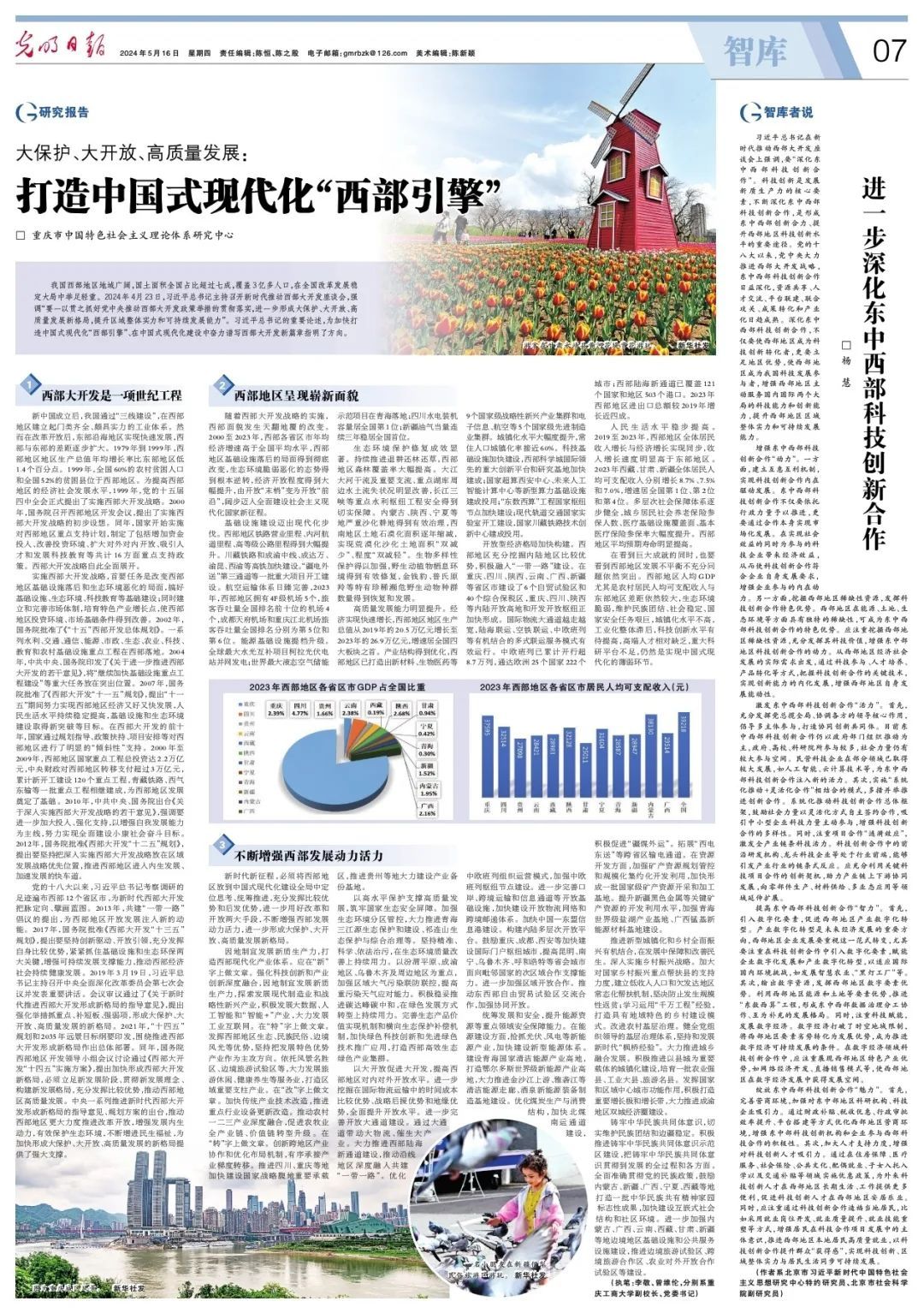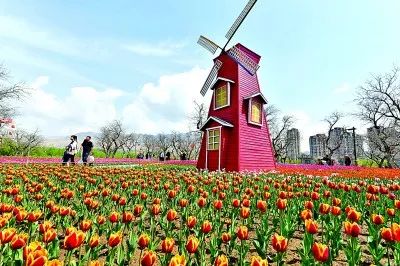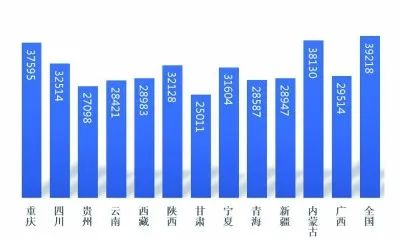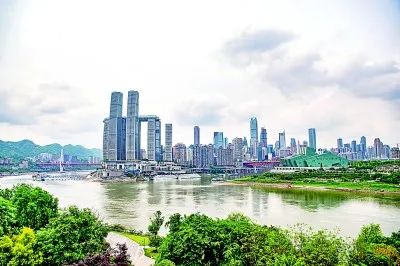Great protection, great openness, and high-quality development:
To create "Western Engine" for Chinese-style modernization


Tourists are enjoying flowers and playing at the Yellow River Flower Embankment in Yongjing County, Gansu Province. The Xinhua News Agency

The proportion of GDP of various provinces, autonomous regions, and cities in the Western Region to the national GDP in 2023

Per capita disposable income of residents in various provinces, autonomous regions, and cities in the Western Region in 2023 (yuan)

The picture shows the scenery of Chongqing urban area. The Xinhua News Agency

A child is playing in the Yili Folk Tourism Area in Xinjiang. The Xinhua News Agency
[Research Report]
The western region of China has a vast territory, accounting for over 70% of the country's total land area and covering over 300 million people. It plays a significant role in the overall reform, development, and stability of the country.
The Western Region of China has a vast territory, accounting for over 70% of the country's total land area and covering over 300 million people. It plays a significant role in the overall reform, development, and stability of the country. On April 23, 2024, General Secretary Xi Jinping presided over a symposium on promoting the development of the Western Region in the new era. He emphasized the need to consistently implement the policies and measures of the Central Committee for promoting the development of the Western Region , further forming a new pattern of comprehensive protection, extensive openness, and high-quality development, and enhancing the overall strength and sustainable development capacity of the region. General Secretary Xi Jinping's important statements provide clear guidance for accelerating the creation of the "Western Engine" for Chinese-style modernization and striving to write a new chapter in the development of the Western Region within the broader framework of Chinese-style modernization.
1. The Western Development is a Century Project
After the establishment of the People's Republic of China, China established a comprehensive and strong industrial system in the Western Region through the "Three Line Construction". However, after the reform and opening-up, the eastern coastal areas achieved rapid development, and the gap between the west and the east gradually widened. From 1979 to 1999, the average annual growth rate of GDP in the Western Region was 1.4 percentage points lower than that in the eastern region. In 1999, 60% of the rural poor population and 52% of poverty-stricken counties in China were located in the Western Region. In order to improve the level of economic and social development in the Western Region , the Fourth Plenary Session of the 15th Central Committee of the Communist Party of China officially proposed the implementation of the Western Development Strategy in 1999. In 2000, the State Council held a conference on the development of the Western Region and proposed preliminary ideas for implementing the Western Development Strategy. In the same year, the country began implementing a key support plan for the Western Region , formulating a total of 16 key support policies, including increasing capital investment, improving investment environment, expanding external and internal opening-up, attracting talents, and developing science and technology education. The Western Development Strategy has been fully launched since then.
The primary task of implementing the Western Development Strategy is to change the situation of backward infrastructure and deteriorating ecological environment in the Western Region , and to do a good job in infrastructure, ecological environment, science and technology education and other basic construction. At the same time, it is also vital to establish and improve the market system, cultivate growth points for characteristic industries, and improve the investment environment and market infrastructure in the Western Region. In 2002, the State Council approved the "10th Five Year Plan for Western Development". A series of key projects in water conservancy, transportation, communication, energy, municipal administration, ecology, agriculture, science and technology, education, and rural infrastructure have been implemented in the Western Region . In 2004, the Central Committee of the Communist Party of China and the State Council issued “Several Opinions on Further Promoting the Development of the Western Region ”, highlighting major tasks such as "continuing to accelerate the construction of key infrastructure projects". In 2007, the State Council approved the "11th Five Year Plan for Western Development", which proposed the goal of striving to achieve good and rapid economic development in the Western Region , continuous and stable improvement of people's living standards, and new breakthroughs in infrastructure and ecological environment construction during the "11th Five Year Plan" period. In the first decade of the Western Development, the country provided significant "tilted" support to the Western Region through planning guidance, policy support, project arrangements, and other means. From 2000 to 2009, the total investment in national key projects in the Western Region reached 2.2 trillion yuan, and the central government transferred more than 3 trillion yuan to the Western Region . A total of 120 new key projects were started, and a number of key projects such as the Qinghai Tibet Railway and the West-East Gas Pipeline were successively completed, laying the foundation for the development of the Western Region . In 2010, the Central Committee of the Communist Party of China and the State Council issued “Several Opinions on Deepening the Implementation of the Western Development Strategy”, emphasizing the need to further increase investment and strengthen support, with enhancing self-development capabilities as the main line, and striving to achieve the goal of building a moderately prosperous society in all respects. In 2012, the State Council approved the "12th Five Year Plan for Western Development", which proposed to prioritize the in-depth implementation of the Western Development Strategy in regional development strategies, and promote the Western Region to enter the fast lane of endogenous and accelerated development.
Since the 18th National Congress of the Communist Party of China, General Secretary Xi Jinping has visited and conducted research in all 12 provinces, autonomous regions, and municipalities in the Western Region . His efforts have provided guidance and laid out a blueprint for the development of the Western Region in the new era. In 2013, the proposal of jointly building the "the Belt and Road" initiative injected new momentum into the opening-up and development of the Western Region. In 2017, the State Council approved the “13th Five Year Plan for Western Development”, proposing to adhere to innovation-driven and openness-led development, fully leverage comparative advantages, firmly grasp the two key points of infrastructure and ecological environment protection, enhance sustainable development capacity, and promote sustained and healthy economic and social development in the Western Region. The meeting reviewed and approved the “Guiding Opinions on Promoting the Western Development in the New Era and Forming a New Pattern”, proposing to strengthen measures, focus on key areas, fill gaps, and strengthen weak areas, forming a new pattern of great protection, great opening-up, and high-quality development. In 2021, the “14th Five Year Plan and the 2035 Vision Goal Outline” were issued, making overall arrangements around promoting the formation of a new pattern in the Western Development. In the same year, the meeting of the Leading Group for Western Region Development of the State Council discussed and approved the "14th Five Year Plan for Western Region Development", proposing to accelerate the formation of a new pattern of Western Region Development, which must be based on the new development stage, implement the new development concept, construct a new development pattern, fully leverage comparative advantages, and promote high-quality development in the Western Region. The issuance of a series of guiding opinions and planning schemes by the central government to promote the formation of a new pattern in the development of the Western Region in the new era has promoted greater efforts in reform and opening-up in the Western Region, enhanced the endogenous driving force of development, effectively protected the ecological environment, continuously improved people's well-being, and provided strong support for accelerating the formation of a new pattern of great protection, great opening-up, and high-quality development.
2. The Western Region presents a new look
With the implementation of the Western Development Strategy, the appearance of the Western Region has undergone profound changes. From 2000 to 2023, the average annual economic growth rate of various provinces, regions, and cities in the Western Region was higher than the national average. The situation of backward infrastructure in the Western Region has been completely changed, the fragile and deteriorating ecological environment has been fundamentally reversed, and the degree of economic openness has been greatly improved. From the "end" of opening-up to the "front" of opening-up, it has taken a big step into a new journey of building a socialist modern country comprehensively.
Infrastructure construction is advancing towards modernization. The railway operating mileage, inland waterway mileage, and high-grade highway mileage in the Western Region have been significantly increased. The construction of the Sichuan-Tibet Railway and high-speed railways such as the Chengdu-Chongqing Middle Line, Chengdu-Dawan Railway, Chongqing-Kunming Railway, and Xi’an-Chongqing Railway is accelerating. A batch of major projects such as the third channel of Xinjiang power transmission have started construction. The air transportation system is gradually improving. In 2023, the Western Region has five 4F-level airports and 4 of the top 10 airports in terms of passenger nationwide. Chengdu Tianfu Airport and Chongqing Jiangbei Airport rank 5th and 6th in terms of passenger nationwide, respectively. Energy infrastructure is also upgraded. The world's largest water solar complementary project, Kola Photovoltaic Power Station, is connected to the grid for power generation; The world's largest liquid air energy storage demonstration project has landed in Qinghai; Sichuan's hydropower installed capacity ranks first in the country; Xinjiang's oil and gas equivalent has consistently ranked first in the country for three consecutive years.
Significant achievements have been made in ecological environment protection and restoration. Continuously promoting the return of farmland to forests and grasslands has significantly increased forest coverage in the Western Region. The soil erosion situation around major rivers, important tributaries, and key lakes and reservoirs has significantly improved, and the safety of key water conservancy projects such as the Three Gorges of the Yangtze River has been effectively guaranteed. Severe desertification of farmland in Inner Mongolia, Shaanxi, Ningxia and other regions has been effectively controlled, and the area of rocky desertification in the Southwest Region has been decreasing year by year, achieving a "double reduction" in the area of desertified and sandy lands and in the degree of desertification. The protection of biodiversity has been strengthened, the habitats of wild animals and plants have been effectively restored, and the populations of unique rare and endangered wild animals such as leopards and gazelles have been restored and developed.
The ability for high-quality development has significantly improved. The economy has achieved rapid growth, with the GDP of the Western Region increasing from 20.5 trillion yuan in 2019 to 26.9 trillion yuan in 2023, ranking first among the four major sectors in China. The industrial structure has been optimized, and the Western Region has created 9 national level strategic emerging industry clusters such as new materials and biopharmaceuticals, as well as 5 national level advanced manufacturing industry clusters such as electronic information and aviation. The level of urbanization has significantly increased, with the urbanization rate of permanent residents approaching 60%. The construction of technological infrastructure has accelerated, and the completion of the internationally leading major innovation platform and research base in the Western Science City has also accelerated; The new computing infrastructure such as the National Supercomputing Xi'an Center and the Future Artificial Intelligence Computing Center has been constructed and put into operation; The construction of national hub nodes for the "East Calculation and West Calculation" project is accelerating; The construction of the National Laboratory of Modern Rail Transit has started, and the National Sichuan Tibet Railway Technology Innovation Center has been completed and put into use.
The construction of an open economic pattern is accelerating. The Western Region fully exploits the comparative advantages of inland areas and actively integrates into the construction of the "the Belt and Road". 6 free trade pilot zones and 40 comprehensive bonded zones have been established in provinces and cities such as Chongqing, Sichuan, Shaanxi, Yunnan, Guangxi, and Xinjiang. The inland open highlands and development hubs such as Chongqing, Sichuan, and Shaanxi are accelerating their formation. The international logistics channels are becoming wider and wider, and the multimodal transportation service models that combine sea-land transportation, air-rail intermodal transportation, and China-Europe freight trains are effectively operating. The China-Europe freight train has operated over 87000 trains, reaching 222 cities in 25 European countries; The New International Land-Sea Trade Corridor in Western China has covered 503 ports in 121 countries and regions. The total import and export volume of the Western Region in 2023 increased by nearly 40% compared to 2019.
The living standards of the people have steadily improved. From 2019 to 2023, the income growth of all residents in the Western Region was synchronized with economic growth, and the income growth rate was significantly higher than that in the eastern region. In 2023, the per capita disposable income of all residents in Tibet, Gansu and Xinjiang will increase by 8.7%, 7.5% and 7.0% respectively, and the increase rates respectively ranked first, second and fourth in China. The multi-level social security system is gradually improving, and the number of urban and rural residents participating in social pension insurance, the coverage of medical infrastructure, and the participation rate of basic medical insurance have significantly increased. The average life expectancy in the Western Region has significantly increased.
While witnessing tremendous achievements, it is also important to note that the problem of imbalanced and insufficient development in the Western Region remains prominent. The gap between the per capita GDP of the Western Region, especially the per capita disposable income of rural residents, and that of the eastern region is still large. The ecological environment is fragile, the task of maintaining national unity, social stability, and national security is arduous, the level of urbanization is not high, the overall level of industrialization lags behind, the level of scientific and technological innovation needs to be improved, high-end talents are relatively scarce, and major research platforms are insufficient, which are still the weak links to achieve Chinese-style modernization.
3. Continuously enhancing the driving force and vitality of Western Development
In the new era and new journey, we must place the Western Region in the overall situation of Chinese-style modernization, think about its positioning, make overall progress, give full play to its comparative advantages and latecomers' advantages, further make good use of the two major means of reform and opening-up, constantly enhance the vitality and momentum of the Western Development, and further form a new pattern of great protection, great opening and high-quality development.
It is important to follow local conditions in developing new productive forces and building a modern industrial system in the Western Region. Efforts should focus on the "new" aspect. It is crucial to strengthen the deep integration of scientific and technological innovation and industrial innovation, develop new quality productivity according to local conditions, explore the development of modern manufacturing and strategic emerging industries, actively develop big data, artificial intelligence and "Intelligence+" industries, and vigorously develop industrial Internet. Efforts should focus on the "special" aspect. It is vital to give full play to the advantages of ecology, ethnic customs, and border scenery in the Western Region, and adhere to the development of characteristic advantageous industries as the focus. By relying on scenic spots, border tourism pilot zones, etc., service industries such as tourism and leisure, health and wellness can be developed, and become important pillar industries in the region.
Efforts should focus on the "change" aspect. It is necessary to accelerate the technological transformation of traditional industries and promote the updating and transformation of equipment in key industries. The deep integration of primary, secondary, and tertiary industries in rural areas should be promoted, and the transformation and upgrading of the entire agricultural and animal husbandry industry chain and value chain should be enhanced.
Efforts should focus on the "transfer" aspect. It is critical to innovate cross regional industrial cooperation and optimize layout mechanisms, and orderly undertake industrial gradient transfer. It is important to accelerate the construction of important carrier areas for the national strategic hinterland in Sichuan, Chongqing and other regions, and vigorously build industrial backup bases in Guizhou and other regions.
High-quality development should be supported with high-level protection and national ecological security barrier could be strengthened. The zoning and control of ecological environment should be strengthened, the ecological protection and construction of the three river sources in Qinghai should be vigorously promoted, and the ecological protection and comprehensive management of the Qilian Mountains should be vigorously enhanced. It is crucial to adhere to precise, scientific, and lawful pollution control, and continue to make efforts to improve the quality of the ecological environment. It is vital to focus on the Fenwei Plain, Chengdu Chongqing region, Urumqi and surrounding areas, so that it is possible to strengthen regional air pollution joint prevention and control, and improve our ability to respond to heavy pollution weather. It is important to actively and prudently promote carbon peak and carbon neutrality, and continue to make efforts in the transformation of green development mode. It is important to improve the mechanism for realizing the value of ecological products and the horizontal ecological protection compensation mechanism, accelerate green technology innovation and the promotion and application of advanced green technologies, and build an efficient ecological green industry cluster in the Western Region.
It is important to promote large-scale development through opening-up, and improve the level of internal and external opening-up in the Western Region. It is important to further explore the comparative advantages of time cost, strategic support, and geographical advantages in international logistics transportation, and comprehensively enhance the level of openness. It is important to further improve the construction of open channels. Big logistics should be driven and big industries through major channels should be fostered. The construction of New International Land-Sea Trade Corridor in Western China should be vigorously promoted, and the deep integration of areas along the line into the joint construction of the "the Belt and Road" should be push forward. The organizational and operational mode of China Europe freight trains should optimized, and the construction of hub nodes for China Europe freight trains should be strengthened. Further improvement on open infrastructure such as ports, cross-border transportation, and information channels should be made, and the construction of open logistics networks and cross-border postal systems should be accelerated. The construction of China ASEAN information ports should be accelerated. A multi-level open platform for inland development should be built. Chongqing, Chengdu, Xi'an and other provinces should be encouraged to accelerate the construction of international gateway hub cities, and improve the sub regional cooperation support capacity of provincial capital cities such as Kunming, Nanning, Urumqi, and Hohhot towards neighboring countries. It is important to further strengthen regional openness and cooperation, promote exchanges and cooperation between the East and West Free Trade Pilot Zones, and strengthen collaborative opening-up.
Development and security should be coordinated, and the security guarantee capabilities in key areas such as energy and resources could be enhanced. In terms of energy construction, the new energy industries such as photovoltaics and wind power should be seized, and the construction of a new energy system should be accelerated. A national clean energy industry highland in Qinghai should be built, and a world-class new energy industry highland in Ordos should be created. There should be vigorous promotion of the construction of clean energy corridors such as the upper reaches of the Jinsha River and the Yalong River, and the Jiuquan new energy equipment manufacturing base. Optimizing the structure of coal production and consumption should be completed, the construction of the North South coal transportation channel should be accelerated, and the "Xinjiang coal export" should be actively promoted. Cross provincial transmission channels such as the "West East Power Transmission" should be expanded. In terms of resource development, the planning and control of mineral resources, as well as the large-scale and intensive development and utilization, should be strengthened, and the formation of a number of national level mineral resource mining and processing bases should be accelerated. It is important to enhance the development and utilization level of key mineral resources such as black metals in Xinjiang, and strengthen the construction of a world-class salt lake industry base in Qinghai and a manganese based new energy material base in Guangxi.
It is important to promote the organic combination of new urbanization and comprehensive rural revitalization, and ensure and improve people's livelihoods in development. The rural revitalization strategy should be deeply implemented. It is important to increase support for key counties for national rural revitalization, establish a normalized assistance mechanism for low-income populations and underdeveloped areas, and resolutely prevent large-scale poverty return; It is important to learn to apply the experience of the "Ten Million Project" to create a rural construction model with regional characteristics. It is important to improve rural grassroots governance. A sound grassroots governance system under the leadership of party organizations should be established, and it is important to adhere to and develop the "Fengqiao Experience" of the new era. Vigorously promotion of the integrated development of urban and rural areas should be made. Urbanization construction with county towns as important carriers should be actively promoted, and a group of strong agricultural counties, industrial counties, and tourist counties should be cultivated. It is important to give full play to the role of national and regional central cities, actively create important growth poles and growth belts, and vigorously promote the construction of the Chengdu Chongqing dual city economic circle.
It is important to strengthen the sense of community among the Chinese nation and effectively maintain national unity and border stability. It is important to actively promote the construction of demonstration zones for strengthening the awareness of the Chinese national community, and implement the awareness of building the Chinese national community throughout the entire process and all aspects of development. It is important to fully and accurately implement the Party's ethnic policy, encourage Inner Mongolia, Xinjiang, Guangxi, Ningxia, Xizang and other places to build a number of landmark achievements of the Chinese nation's shared spiritual home, and accelerate the construction of an embedded social structure and community environment. It is important to further strengthen the construction of infrastructure and public service facilities in border areas of Inner Mongolia, Guangxi, Yunnan, Xizang, Gansu, Xinjiang and other places, and promote the construction of border tourism pilot zones, cross-border tourism cooperation zones, and agricultural opening up cooperation pilot zones.
(Author: Chongqing Research Center for the Theoretical System of Socialism with Chinese Characteristics, written by Li Jing and Zeng Weilun, respectively, Vice President and Party Secretary of Chongqing Technology and Business University)
Source: Guangming Daily
https://epaper.gmw.cn/gmrb/html/2024-05/16/nw.D110000gmrb_20240516_1-07.htm

